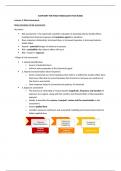Summary
Summary Food Toxicology TOX-30306
- Course
- Institution
GRADE: 8.5. This document is a summary of the course Food Toxicology (TOX-30306). It includes lectures 2 through 15. Please note that this summary was written during the 2023/2024 academic year, and the content may have changed since then. Therefore, consider these documents as supplementary suppor...
[Show more]



